To be considered professional, soccer field lighting must adhere to established regulations and guidelines. Meeting these standards ensures that the field is equipped to host semi-professional and professional soccer events, providing optimal visibility for players, spectators, and television crews. But what are the specific regulations and requirements that your soccer field needs to meet to achieve this level of professionalism?
Table of Contents
ToggleImportance of Complying with Soccer Field Lighting Standards
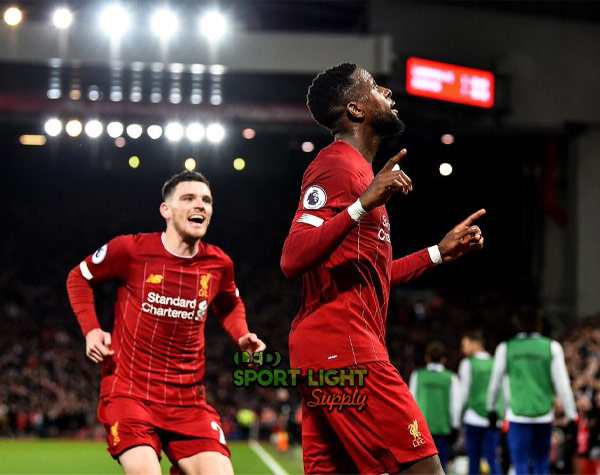
Enhanced Visibility for Soccer Players
Proper lighting is crucial for soccer fields, as most of the action occurs on the ground. To achieve optimal visibility, fields must be well-lit with horizontal illumination. This type of lighting is provided by high mast poles equipped with light fixtures, ensuring that the entire playing surface is illuminated. Such lighting allows athletes to see the field clearly, enhancing their performance and reducing the risk of accidents.
Improved Vertical Illuminance for Camera Work
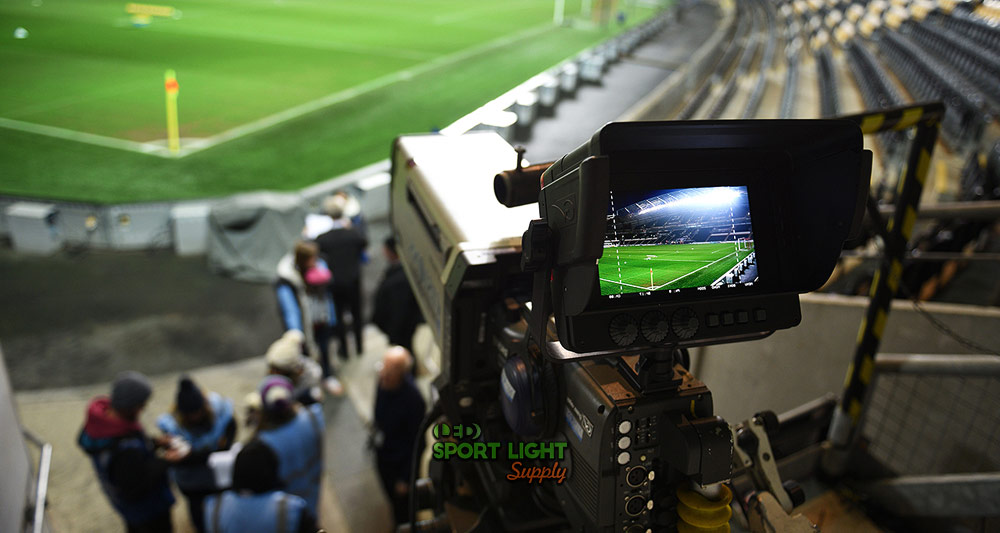
Vertical illumination is essential for television broadcasts and is also beneficial for spectators. This type of lighting reduces ground shadows that overhead lights might create, ensuring that objects and players are evenly illuminated from all angles. With effective vertical illumination, players benefit from better visibility on the pitch, and the quality of televised coverage improves, showcasing the game in the best possible light.
Enhanced Visibility for Judges and Spectators
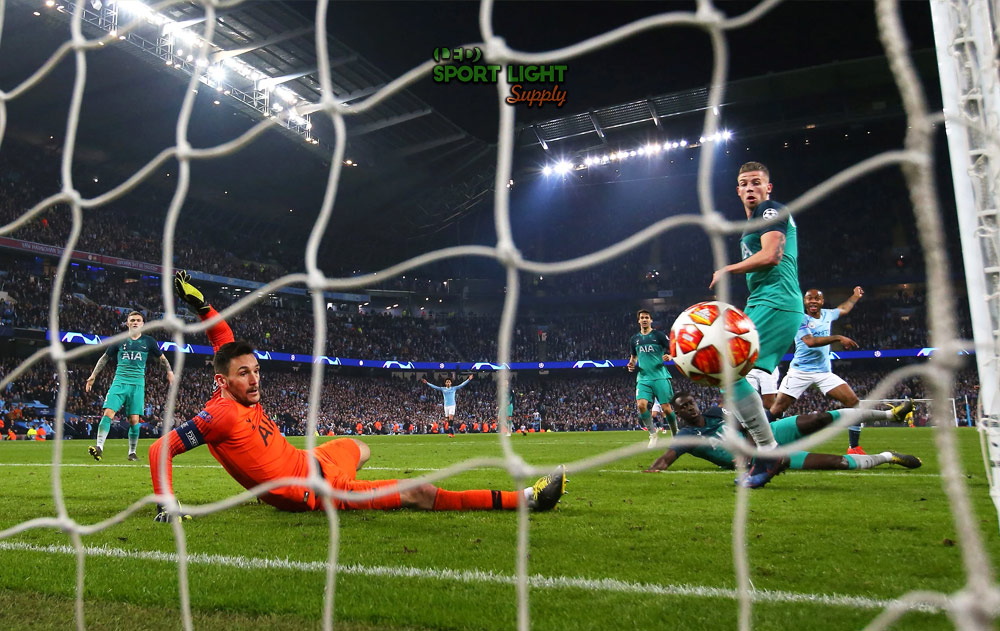
Meeting lighting standards is not just a regulatory requirement but also enhances the overall experience for judges and spectators. High-quality lighting systems help eliminate overhead shadows, making it easier for referees to make accurate calls and for spectators to follow the action. This standard is increasingly being adopted by college and high school fields, as it elevates the professionalism of the event and appeals to a broader audience.
| Lighting Aspect | Description |
|---|---|
| Horizontal Illumination | Ensures clear visibility of the playing field. |
| Vertical Illumination | Reduces shadows and improves camera visibility. |
| Spectator and Judge Visibility | Enhances overall experience and professionalism. |
Soccer Field Lighting Standards
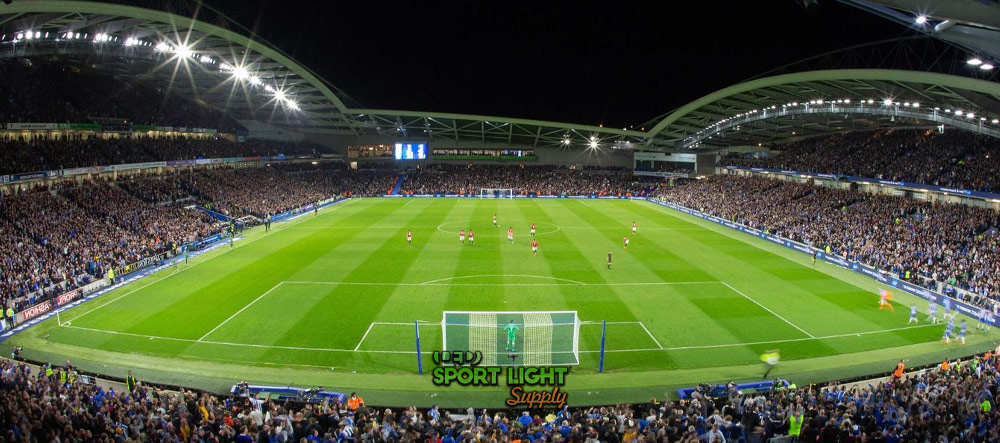
Brightness (Lux) Requirement for Soccer Field Lighting
The required brightness for soccer field lighting varies depending on the level of competition. Different levels of Lux and foot candles impact visual clarity on the field. Below is a breakdown based on class ratings.
Class 1 (Professional and Championship Soccer Games)
For professional soccer matches, the lighting requirements start at 500 Lux and can go up to 750 Lux. When matches are televised, the minimum lighting requirement increases to 800 Lux. National and international events, such as the Olympics and FIFA tournaments, may require up to 1500 Lux with a lighting uniformity of at least 0.8.
| Lux | Foot Candles |
|---|---|
| 500 | 46,468 |
| 750 | 69,702 |
| 800 | 74,349 |
| 1500 | 139,405 |
Class 2 (Semi-Professional, High School, Upper-Level Training)
For semi-professional and high school soccer fields, the lighting requirements range from 200 to 500 Lux. This level of lighting is suitable for training and matches where lower light levels can help reduce excitability and the risk of injuries.
| Lux | Foot Candles |
|---|---|
| 200 | 18,587 |
| 500 | 46,468 |
Class 3 (Local Competition Training, School and Recreational Soccer Pitch)
Local competition and recreational fields require lighting between 75 and 200 Lux. This level is adequate for everyday games and training on local parks and school fields.
| Lux | Foot Candles |
|---|---|
| 75 | 6,970 |
| 200 | 18,587 |
Lighting Uniformity Requirement
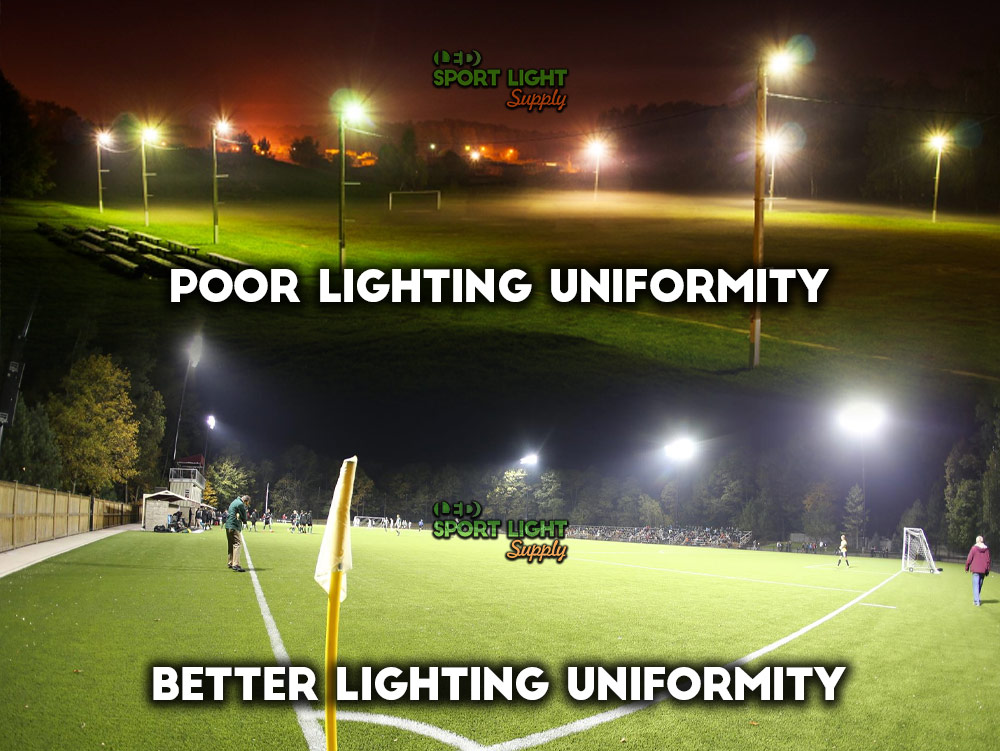
Lighting uniformity measures both vertical and horizontal light distribution on the field. Each section measured must meet or exceed the specified uniformity levels.
| Class | Uniformity Requirement |
|---|---|
| 1 | ≥0.7 |
| 2 | ≥0.6 |
| 3 | ≥0.5 |
Light Pole Layout
4-Pole (Class 3)
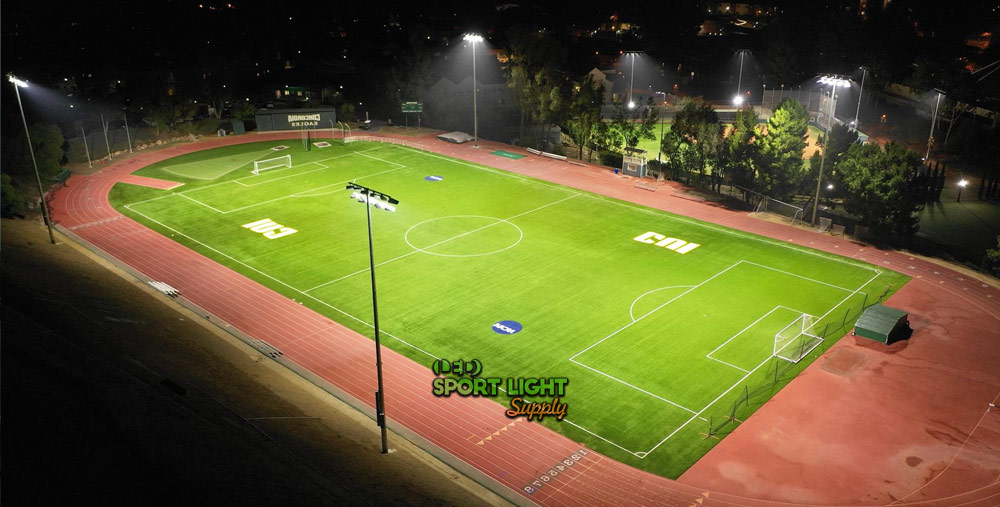
This layout is suited for recreational and training fields. Typically, four light poles are placed around the penalty area line. If there are bleachers, the poles are positioned behind them, with one pole at each corner of the bleachers.
6-Pole (Class 2)
Designed for semi-professional and club training fields, this layout includes two light poles on opposite sides of the halfway line and one pole at each corner of the field. If bleachers are present, the poles are placed behind them but remain centered along the halfway line.
8-Pole (Class 1)
Used for national and league matches, this setup involves one light pole at each corner of the pitch and two additional poles evenly spaced along the center line, making a total of eight poles. For fields with bleachers, poles are positioned behind them at the corners.
Light Pole Height Standard
The standard height for football light poles is around 70 feet for a 4-5 pole setup on an average pitch. Stadiums may require taller masts based on their size. Vertical lighting is also used to fill shadows and ensure players are well-illuminated. Classes 1 and 2, used for professional and semi-professional games, typically incorporate vertical lighting along with the primary light poles.
Color Temperature
The color temperature of lighting is typically dictated by the regulations of each class. For stadium lighting used in television broadcasts, a color temperature of 5500K is required to ensure optimal visibility and color accuracy. In contrast, standard fields generally use a color temperature of 4000K. For training fields that are not subject to regulation, a warmer color temperature starting at 3500K is often sufficient. However, regulation fields, particularly those used by official soccer clubs, typically require a color temperature of 5000K to meet professional standards.
CRI (Color Rendering Index)
The Color Rendering Index (CRI) is crucial for determining how well light sources render colors in comparison to natural light. On a soccer field, maintaining accurate color representation is essential to avoid color washout. For professional fields, a CRI of 86 is often used to ensure the sharpest detail and color clarity. A higher CRI can lead to overexposure and washed-out colors, which is undesirable for precise visual assessment.
Glare Regulation
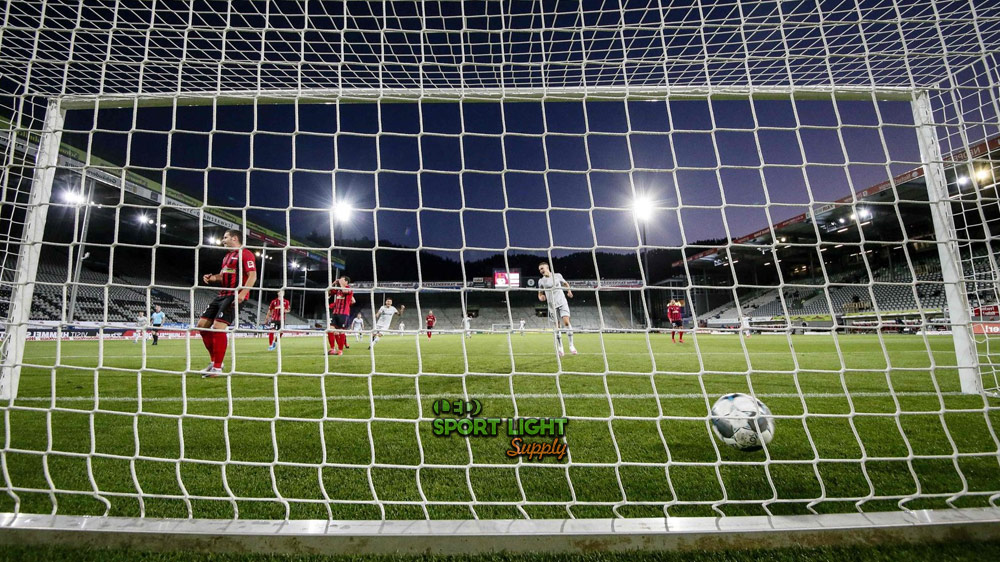
Glare control is essential in stadium lighting to prevent excess light spill and ensure that light is focused where it is needed. Regulation requires that LED soccer field lights meet a glare rating of GR<50. This rating ensures that the light is highly focused with minimal spill, preventing interference with players’ and spectators’ viewing experiences. Proper glare control makes the lighting less distracting and reduces visual irritation.
Shadow Management
Lighting configuration on soccer fields inevitably produces shadows. To address this, vertical lighting is employed at professional matches to reduce horizontal shadows created by light poles. Additionally, perimeter fill lighting is strategically placed around the pitch to minimize shadows and enhance the illumination of players and objects on the field. Smaller fields with 4-6 light pole setups may experience more significant shadows if fill lights are not utilized.
Flicker Reduction
Flicker is a common issue with various traditional lighting fixtures such as metal halide, high-pressure sodium, and halogen lights, though ballasts can mitigate this problem. LED lighting, however, does not exhibit visible flicker. Even under slow-motion cameras with higher frame rates, any flicker present is typically imperceptible. If flicker is detected, advanced computer software can eliminate video frames that do not contribute to a clear image, ensuring smooth visual performance.
Advantages of Using LED Soccer Stadium Lighting
Energy Efficiency and Reduced Running Costs
LED lighting has revolutionized the energy consumption and operational costs associated with sports and soccer field lighting. Traditional filament-based light fixtures, which are still prevalent worldwide, are notorious for their inefficiency, leading to substantial electricity wastage and higher expenses. In contrast, LED lighting offers a significant reduction in energy consumption, translating to savings of approximately 75-85% on electricity bills. This substantial decrease in running costs makes LED lights both economically and environmentally beneficial.
Uniform Lighting
Uniform lighting is crucial in professional soccer matches due to stringent regulations. LED lighting systems provide consistent illumination across the pitch, adhering to these standards. The effectiveness of the lighting is evaluated using specific testing methods that measure the light intensity at various points on the field. The pitch is divided into a grid, and each section is assessed through two types of light measurements: horizontal and vertical. These measurements are analyzed to ensure even distribution of light across the playing surface.
Instant On/Off Capability
One of the key advantages of LED lighting is its immediate brightness upon activation. Unlike filament bulbs, which require a warm-up period, LED lights reach full luminosity as soon as electricity is supplied to the semiconductor. This is in contrast to metal halide and high-pressure sodium (HPS) lights, which may take up to 20 minutes to fully illuminate and require additional time to cool down before being turned on again. LED lights offer the convenience of instant on/off functionality, making them highly versatile for various lighting needs.
Long Lifespan
LED lights are renowned for their extended lifespan compared to other lighting technologies. With advancements in LED technology, these lights can last between 80,000 to 100,000 hours, significantly outperforming high-pressure sodium (HPS) and metal halide lights, which typically have a lifespan of around 2 years. This longevity translates to up to 25 years of reliable performance for LED lights, making them a cost-effective solution for sports lighting over time. The durability and long operational life of LED lights contribute to their overall efficiency and reduced maintenance costs.
Soccer Field Lighting Standards Q & A
How Many Lumens Does It Take to Light a Soccer Field?
The lumen requirement for soccer fields varies based on the level of play and the specific needs of the field. Soccer fields come in different sizes depending on the age group or league. The lumen levels can be categorized into three classes:
| Field Classification | Lumen Requirement |
|---|---|
| Class 3 Fields (Recreational Games) | Approximately 350,000 lumens |
| College or Semi-Professional Fields | About 450,000 lumens |
| Professional League Fields | Ranges from 500,000 to 1,500,000 lumens |
What Types of Lights Do Soccer Stadiums Use?
Soccer stadiums require high-power floodlights to adequately illuminate the large area of the pitch. Typically, these are 1500-watt floodlights that are specially designed to minimize light bleed and focus illumination on the field. A 1500-watt fixture produces around 200,000 lumens, ensuring that the field is brightly lit for both play and broadcast purposes.
Common Soccer Field Lighting Standards
NCAA Lighting Requirements
The NCAA focuses on the number of foot-candles required for soccer games across different levels of play. They mandate a minimum number of poles for lighting, ranging from 6 or more, and allow for 75-125 vertical foot-candles per square foot, depending on the event’s significance.
UEFA Lighting Requirements
UEFA has strict lighting standards for stadiums, categorized into four levels of horizontal illumination measured in lux:
| Lighting Level | Horizontal Illumination (Lux) | Description |
|---|---|---|
| Level A | 2000 Lux | Reserved for elite events such as FIFA championships and finals. |
| Level B | 1400 Lux | For major tournaments and final qualifying matches. |
| Level C | 1200 Lux | For first and second qualifying matches. |
| Level D | 800 Lux | Suitable for qualifying rounds, women’s matches, and youth matches. |
IES Lighting Requirements
The Illuminating Engineering Society (IES) provides guidelines for soccer field lighting with lux ratings corresponding to foot-candle measurements:
| Lighting Level | Horizontal Illumination (Lux) | Vertical Illumination (Foot-Candles per Vertical Square Foot) |
|---|---|---|
| Level A | 750 Lux | 75 foot-candles |
| Level B | 500 Lux | 50 foot-candles |
| Level C | 300 Lux | 30 foot-candles |
| Level D | 200 Lux | 20 foot-candles |
UIL Lighting Requirements
The University Interscholastic League (UIL) sets standards for college soccer fields that are not intended for high-profile televised events. Their regulations specify 30-50 foot-candles per square foot for a field size of 360′ x 225′. The lighting design typically involves 4-6 poles.
| Organization | Lighting Level | Horizontal Illumination (Lux) | Vertical Illumination (Foot-Candles) | Field Size (Feet) | Number of Poles |
|---|---|---|---|---|---|
| NCAA | Regional/National/Championship | 75-125 foot-candles per square foot | – | – | 6 or more |
| UEFA | Level A | 2000 Lux | – | – | – |
| UEFA | Level B | 1400 Lux | – | – | – |
| UEFA | Level C | 1200 Lux | – | – | – |
| UEFA | Level D | 800 Lux | – | – | – |
| IES | Level A | 750 Lux | 75 foot-candles per vertical square foot | – | – |
| IES | Level B | 500 Lux | 50 foot-candles per vertical square foot | – | – |
| IES | Level C | 300 Lux | 30 foot-candles per vertical square foot | – | – |
| IES | Level D | 200 Lux | 20 foot-candles per vertical square foot | – | – |
| UIL | College Fields | 30-50 foot-candles per square foot | – | 360′ x 225′ | 4-6 poles |
Conclusion
Recreational fields typically need around 350,000 lumens, while college or semi-professional fields require approximately 450,000 lumens. Professional league fields can demand between 500,000 and 1,500,000 lumens to meet high-visibility needs. Lighting standards from organizations like NCAA, UEFA, IES, and UIL offer detailed guidelines, ensuring that lighting meets the necessary criteria for visibility, performance, and broadcast quality. Selecting the appropriate lighting system based on these standards enhances the playing experience and supports the overall success of soccer events.
